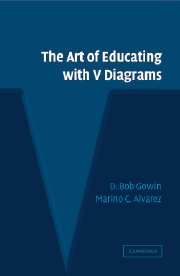Book contents
- Frontmatter
- Contents
- Foreword
- Preface
- Acknowledgment
- PART ONE FOUR COMMONPLACES OF EDUCATING PLUS ONE
- PART TWO THE V DIAGRAM
- PART THREE ANALYZING, EVALUATING, AND CONDUCTING RESEARCH
- Evaluating V Diagrams
- 8 Researching Educating
- Part 3 Summary
- PART FOUR REASONING WITH TECHNOLOGY
- Part 4 Summary
- Epilogue
- Appendices
- Bibliography
- Name Index
- Subject Index
Evaluating V Diagrams
Published online by Cambridge University Press: 19 November 2009
- Frontmatter
- Contents
- Foreword
- Preface
- Acknowledgment
- PART ONE FOUR COMMONPLACES OF EDUCATING PLUS ONE
- PART TWO THE V DIAGRAM
- PART THREE ANALYZING, EVALUATING, AND CONDUCTING RESEARCH
- Evaluating V Diagrams
- 8 Researching Educating
- Part 3 Summary
- PART FOUR REASONING WITH TECHNOLOGY
- Part 4 Summary
- Epilogue
- Appendices
- Bibliography
- Name Index
- Subject Index
Summary
Principle 7. The V Diagram of the structure of knowledge provides a basis for evaluating. The developer of a diagram judges worth by criteria of congruence–correspondence, coherence–conceptual clarity, the question–event connection, and the fit between questions asked and answers given.
Evaluating anything needs some working concept of value. Evaluating a scientific research publication requires a concept of the value of Science. In general, scientists value Science as a way to get at the truth about reality. They can undertake theoretical and experimental manipulations of nature to get at what is not known. The theoretical papers of Einstein in 1905 upset several sets of scientific beliefs (the photoelectric effect, for example). His work over a lifetime changed modern physics because his ideas were verified. Verification requires many tests of many aspects of scientific claims by many different minds working at many different places. Over time the Truth (or the many truths) is expressed by the communities of scientists working out their agreements about the value of scientific claims.
Philosophy of Science presents two theories of Truth: Correspondence and Coherence. Historically, the correspondence view is attributed to Aristotle and the coherence view to his mentor, Plato. The views of these two great philosophers have been widely debated, challenged, revised, changed, and, often, dismissed by working scientists. In our critical analysis of over 3,000 works of science, we have adopted and adapted a view of scientific value useful in V diagram analysis.
- Type
- Chapter
- Information
- The Art of Educating with V Diagrams , pp. 103 - 124Publisher: Cambridge University PressPrint publication year: 2005



